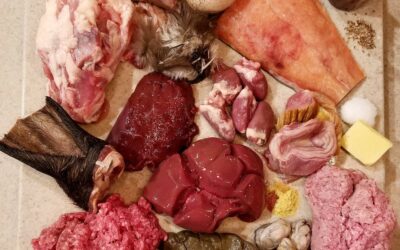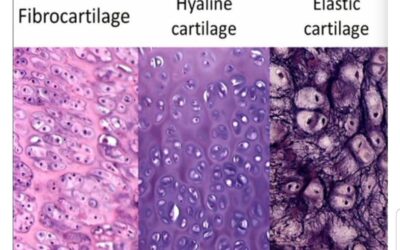Over the ages carefully selected breeding has brought out both physical and instinctive character traits in dogs for the purpose and benefit of the needs of mankind. Dogs were selectively bred for function, intelligence, protection, loyalty, submissiveness, trainability, friendliness, companionship, sport, size, appearance, strength, their acute senses, and for the their natural hunting, herding, working, and guarding abilities. As a result of the carefully selected breeding, these specific genetic traits have been funneled down to limited gene pools to create the hundreds of “pure” breeds of dogs we see today. But despite the incredible variation in appearance and characteristics within canis lupus familiaris, what has remained virtually unchanged is the domestic canine’s internal physiology.
For likely millennia, domestic dogs have been consuming food found in nature as well as food provided by their human caretakers. While many domestic dogs where fortunate (or not so fortunate) to rely on hunting and foraging instincts for their nutrition needs, many more were thrown and fed table scrapes from home prepared foods and meals. Processed foods were not a part of our history until the Industrial Revolution boomed. As early as 1860, commercially prepared and sold dog biscuits were introduced to the public. Englishman James Spratt is credited with inventing the first commercial dog biscuit. It is reported that his idea to create a commercial dog food was inspired by his observation of sailors throwing hardtack to dogs at the ship docks. The biscuits were made from vegetables, beef blood, wheat, and beet root. This simple way to feed dogs became so popular that by 1890, commercial pet foods spread to the United States. And the rest is history. Unfortunately, chronic illnesses and premature death rates started to soar and many people who were relying on commercial feeds were losing not just their dogs to malnutrition, but other livestock also consuming commercially prepared diets. Thanks to AAFCO, we now know what nutrients our dogs require to live healthy lives. And this now begs the question, while we know what nutrients our beloved dogs require, what are the best foods to provide those essential nutrients? One way to answer this question is to observe and analyze the canine anatomy and physiology to deduce and determine what a dog is designed to consume.
Beginning with the head, the dog’s frontal eye placement gives them the advantage of a peripheral view of their surroundings. The hinged canine jaw is equipped with reasonably large and powerful muscles to grab, hold, and crush. The mandibular hinge joint enables a dog to open their mouths impressively and dangerously wide. Their forty-two teeth consist of four long pointed canines for grabbing and holding prey, twenty-six sharp serrated-like molars for cutting, tearing, chopping, and shredding hide, skin, feathers, fur, muscles, flesh and sinew as well as crushing and breaking bone, and twelve front incisors to gnaw and pull sinew from bones. Because the canine’s teeth do not meet or line up, they are not able to grind and chew food into pulp. Equally muscled and powerful is the thick canine neck. The entire canine anatomical structure makes them natural athletes. Their bodies are perfectly suited for running, jumping, and changing direction in a split second. This beautiful design allows them to efficiently chase down prey. We can determine further what a dog is designed to eat by examining their digestive faculties.
Mouth: When food enters the dog’s mouth (as well as at the sight or smell of food), salivary glands begin to secrete saliva consisting of water, bicarbonate, and proteins (enzymes) to moisten food for swallowing. Dogs do not have lateral movement in their jaw and, as noted above, do not have flat molars that are in-line or meet, thus they do not chew or grind their food into pulp. In general, they use their teeth to break down their food small enough to swallow. Many people erroneously point out that dogs do not produce or secrete salivary amylase, the enzyme which initiates carbohydrate digestion. Part of this confusion comes from statements made by veterinarians such as Dr. Colin Harvey, emeritus professor of surgery and dentistry at the School of Veterinary Medicine at the University of Pennsylvania. He is noted as stating, “There are no digestive enzymes present in the saliva of dogs. It is purely designed to get the food down into the stomach so the digestive process can start.” However, a recent groundbreaking research study that was published online August 22, 2017 on BMC Veterinary Research website may have just dispelled a long held belief about canine saliva. The study is found under the headline, “Detection and measurement of alpha-amylase in canine saliva and changes after an experimentally induced sympathetic activation.” The conclusion of the study states, “This study demonstrates that there is alpha-amylase in saliva of dogs and validates a reliable spectrophotometric assay to measure this enzyme in this species with a good precision, sensitivity and accuracy. In addition, it reports a sAA [salivary alpha-amylase] activity increase after an experimental model of sympathetic activation in the dog and suggests that sAA could be potentially used as non-invasive biomarkers of sympathetic activation in this species.1” Notably, salivary amylase is found mostly in omnivores, only few herbivores, and absent in obligate carnivores. What is interesting regarding herbivores is that the three domestic carbohydrate-consuming animals, cows, sheep, and goats, were not found to produce salivary amylase. Therefore, pointing to salivary amylase clearly cannot tell us for certain what a dog is designed or not designed to consume. Dog saliva is, however, antibacterial containing simple proteins called histatins which is suitable when consuming raw and often rotting flesh to prevent against infection. Carbohydrate-consuming cattle, on the other hand, have highly alkaline saliva specifically designed to keep bacteria alive. For the canine, an additional protein in their saliva known as nerve growth factor (NGF) serves to help with healing wounds as dogs lick to self-treat their wounds.
Stomach, small intestine, large intestine: Dogs have a relatively short digestive tract. This allows for food to pass quickly through the system preventing the proliferation of pathogenic bacteria yet also inhibiting the thorough breakdown of whole plant matter. A domestic canine’s stomach has the ability to adjust pH from extreme acid with a pH of 1 up to a pH of 5 in the presence of carbohydrates. The ideal stomach pH range for digestion is 1-2. A dog’s stomach has the ability to stretch to accept very large meals. The stomach secretes the enzyme pepsin to break down protein molecules by separating the peptide bonds that hold the amino acids together. It also secretes gastric lipase, the enzyme that initiates the breakdown of fats. The stomach initiates the digestion of carbohydrates as well. Whether or not gastric amylase is produced is not documented; however, the low pH of the stomach stimulates the pancreas to secrete pancreatic enzymes into the small intestine which includes amylase for carbohydrate digestion. The food is churned together inside the stomach creating a mass called chyme. The chyme then passes through the pyloric valve and enters into the small intestine.
The small intestine of a dog has a length of three times their body length. Comparatively, a cow’s intestine is twenty times its body length (about 120-150 feet) while a human’s small intestine is about four times their height. This is where the majority of digestion takes place. The chyme is mixed with bile and enzymes secreted by the pancreas to begin unlocking nutrients from the food. The lining of the small intestine is covered with hair-like structures called villi on which are found microvilli. This increases the surface area of the intestinal wall for the purpose of optimal nutrient uptake and absorption. It is through these microvilli where the nutrients pass through the intestinal wall, via passive or active transport, and enter into the bloodstream where the nutrients are dispersed throughout the body.
From the small intestine, undigested food moves into the large intestine. The large intestine has two main functions: 1) water, electrolyte, and vitamin B12 absorption and 2) short chain fatty acid and vitamin production via the microbiome. From here, waste is eliminated from the body via the rectum.
Pancreas and liver: The pancreas has a two-fold purpose. It is both an endocrine organ and a digestive organ. Its vital purpose is to produce and secrete digestive enzymes and the hormones insulin, glucagon, and gastrin. The pancreas also contains bile ducts throughout its length that connect to bile ducts from the liver.
The liver has 500 roles in the dog’s body. Some of the liver’s roles include detoxification, protein metabolism, the production of digestive chemicals, the production of bile, the breakdown of fats, and it acts as a storehouse for glycogen (sugar for energy), Vitamins A, D, E, K, and B12, iron, and copper.
Thus, we can deduce and conclude that the canine digestive faculties are best suited to consume whole prey. However, while the canine teeth and digestive tract are in fact most suited for the purpose of consuming and digesting animal flesh and bone, dogs are not obligate carnivores. An obligate carnivore must consume prey or death will occur in a short time. Physiologically, dogs are what are known as facultative carnivores, or versatile carnivores. Facultative carnivores do best on a prey diet; however, they have the ability to survive on an omnivorous diet for extended periods in the absence of prey. This does not mean that a dog can thrive on an omnivorous diet, what it tells us is dogs have an ability to keep death at bay by turning on gene expression to switch, if you will, to an omnivore for extended lengths such as for a season in the absence of prey, but certainly not for years as indicated by observed cellular damage that begins to surface in dogs fed high-carbohydrate diets. It is well known and documented that dogs thrive on a prey diet that is low in or even absent of carbohydrates. In fact, is has been determined that dogs have no need for carbohydrates in order to thrive. When dogs do consume a carbohydrate-based diet they are often stricken with obesity and chronic conditions and disease. Dogs who consume kibble, dehydrated high-carb commercial foods, and often homemade diets containing large amounts of oatmeal, potatoes, peas, legumes, quinoa, and other grains and starches are generally the unfortunate victims who suffer most.
We can also learn what is best to feed our domestic canine by looking at the diet of the wolf. It has been established that wolves are nearly identical in DNA to our domestic dogs differing only by a mere 0.2%. Thankfully, the Department of Environmental & Natural Resources conducted such a study. The 2002 to 2013 research study evaluated the contents of collected stomachs and scat from wolves that had been hunted in the North West Territories. While whole prey was the most frequently found stomach contents, garbage followed closely behind. According to the manuscript written by Nicholas C. Larter in 2016, “Counting human garbage, there were 24 different distinguishable items recorded including ungulates (caribou), moose, wood bison and deer, furbearers and small mammals, snowshoe hare, beaver, voles, birds, fish, vegetation, and one domestic dog. Most items were found in both stomach contents and scats with the exception of garbage, fish, lynx, porcupine, raptor, and domestic dog being reported only from stomach contents and deer, ants, and mink only being reported from scat contents.2” What was interesting was the fact that vegetation was found at a 14.6% frequency while all individual prey was lower than a 15% frequency with the one exception being caribou which was found at a 34% frequency. Human garbage was a whopping 23.6% frequency. Birds, hares, marten, and rodents, were the next most frequently found prey ranging from 12% rodents to a collective total of various birds at 19% (ranging individually from 7% to 12%).
This is a mere one study from one location, but we can see from this collection of data that wolves are prey driven as well as opportunistic. The frequency of garbage and vegetation consumption shows just how opportunistic and versatile wolves truly are. And, the same holds true for our domestic canines. We can see quite clearly that over the past one hundred fifty years, most dogs consumed commercial dog food. Kibble gained popularity for its simplicity and affordability. Kibble also proved the facultative nature of our canine companions. Since kibble was and still is primarily carbohydrates with low quality protein sources, the fact that domestic dogs have not been exterminated by the pet food industry speaks volumes. Let’s look at this further.
Over the past one hundred fifty years of commercial dog food production, scientific study and the nutritional analyses of canine needs and requirements has increased and improved. One such recent scientific study looked at the DNA of wolves and domestic dogs comparing the genes that code for pancreatic amylase. Pancreatic amylase is the enzyme required for carbohydrate digestion and assimilation. What the study showed us is wolf DNA contains a mere two gene copies that code for amylase while the domestic dog’s DNA contains anywhere from four to thirty gene copies that code for amylase. This is a possible twenty-eight fold increase in this gene expression in some of our domestic breeds compared with their near-identical DNA counter-part the wolf. Carol Beuchat, PhD wrote an article outlining the AMY2B amylase gene code in an article entitled, “A Key Genetic Innovation in Dogs: Diet3” where she outlines the specific findings. So what does this mean? These findings show the canine’s ability to turn gene expression on and off as a direct result of carbohydrate consumption, hence their facultative ability. Additionally, this shows us that nutrition plays a major role in influencing DNA. It should be clearly understood that this adaptation in the absence of prey is a survival mechanism. It allows for the dog to survive, yet not necessarily thrive. For our domestic companions, the gene expression has been turned on and thus passed along to the next generations as a result of their consistent (long-term) consumption of commercially produced pet foods.
Long before studies such as this provided DNA based findings, observation alone proved the facultative nature of the dog. As noted above, the fact that dogs have not been exterminated as a result of their consumption of high-carbohydrate processed foods is proof enough. It is unfortunate, however, that this adaptive trait has been abused by dog food companies in an attempt to promote their kibbles and claims that dogs are omnivorous and not true carnivores. As clearly discussed above, nothing could be further from the truth and is clearly indicated by the rapid increase in chronic disease and mortality among domestic dogs. Just because a dog can be nutritionally abused without dying immediately does not make it right to subject them to a lifetime of cellular onslaught and the increased potential for chronic disease and reduced longevity.
On account of the increase in chronic disease and mortality among pets, a return to homemade meals for the family dog began to surface and regain popularity. This sudden new wave of feeding the four-legged family member demanded that we take a critical look at how and what we feed our dogs. Dr. Ian Billinghurst, an Australian veterinarian, was one such person who understood that a dog’s health and wellness was dependent upon consuming a species-appropriate diet. His now famous book, “Give Your Dog a Bone,” released at a Bichon Frise convention in Sydney on November 17th in 1993, gained tremendous attention, both good and bad. Worldwide, people began to slowly gain the confidence and take the responsibility to feed their dogs a fresh, whole food diet. Unfortunately, this was bad news for the dog food industry. This nutritional plan became known as the BARF diet; initially Bones and Raw Food, it is now known as Biologically-Appropriate Raw Food. Due to Dr. Billinghurst’s effort, several more raw food models began to develop along with clever advertising from the pet food industry and the promotion of false studies and claims in order to convince pet parents that they alone, the giants of the pet nutrition world, knew how best to feed our beloved pets. However, this also led to the production of commercially prepared raw food diets.
Enter the American Association of Feed Control Officials (AAFCO) and the National Research Council (NRC). AAFCO was established to discover which nutrients needed to be added to commercial feed to prevent the death of dogs consuming the commercial pet foods. Just as the United States Recommended Daily Allowance (USRDA) was established during WWII to prevent disease and malnourishment in soldiers overseas and in combat zones, AAFCO was established for a similar purpose: to prevent malnourishment and death in pets consuming commercial feed. Understand that the USRDA was established to set standards that prevented disease and death, not to keep people well long-term, and so too, AAFCOs minimum nutrient requirements are not meant to necessarily produce optimal health, but to provide a standard that prevented nutrient-deficient pathologies and death in pets consuming commercially processed foods. Since 1930, AAFCO’s established Proficiency Testing Program has supported feed-testing laboratories utilizing their four unique proficiency testing schemes to ensure pets receive the nutrients they need. Like AAFCO, the NRC serves to review published research followed by generating nutrition reports based upon said research. This research is completed to set a standard and to serve as a guide that establishes minimum and maximum nutrient requirements for processed foods. Minimums are necessary to set the floor or baseline requirements in order that pet foods not fall below.
Taking this a step further, it must be understood that the levels of nutrients that AAFCO and the NRC recommend is for processed pet foods that contain synthetics and inorganic compounds, not naturally occurring whole-food nutrients. Synthetic nutrients and inorganic mineral compounds are not as well absorbed or assimilated. Many of these synthetics even create imbalance and can possibly lead to a disease condition as some studies are now proving. Thus, the nutrient recommendations are not based on a diet consisting of fresh raw proteins and fats and naturally occurring co-factors, enzymes, antioxidants, vitamins, and minerals found in whole foods such as prey and plants. This makes all the difference in the world because nutrition is meant for one purpose: to provide and deliver synergistically balanced nutrients that results in a harmonious metabolic dance of chemistry with the biological systems. Synthetics are man-made isolates that do not work harmoniously and naturally in physical bodies, and this includes so-called “natural” isolates. Biological systems must adjust for the synthetics, while inorganic minerals hardly mimic the minerals that are found in whole foods. Literally and simply, inorganic mineral supplements are industrial rock known as mineral salts. Since 1947, naturopathy “does not make use of synthetic or inorganic vitamins or minerals.” And neither should our companion pets.
What does all this translate to for the pet parent wanting to feed a homemade raw meal? AAFCO and the NRC were established for processed pet foods…period. If anything, AAFCO and the NRC have determined the minimum requirements for adulterated protein and rendered fat along with synthetic vitamin and inorganic mineral needs to prevent death in dogs. What we really need to ask is, how does this equate to fresh whole foods that are not void of enzymes and co-factors and contain fresh unadulterated proteins, raw fats, and naturally occurring nutrients working synergistically and in balance? The answer is, it does not and cannot because we are considering completely different chemistry and biochemical action. What we can do is use NRCs minimum nutrient recommendations as a reference only. With that, let us move onto the macro and micronutrients that need to be included in your dog’s daily meals.
©2019 Kimberly Lloyd, PhD, BCHHP, Cert Raw Dog Food Nutritionist
1 Maria Doloras Contreras-Aguilar, Fernando Tecles, Silvia Martínez-Subiela, Damián Escribano, Luis Jesús Bernal, and José Joaquín Cerón, BMC Veterinary Research, August 22, 2017, www.ncbi.nlm.nih.gov/pmc/articles/PMC5568211/#__ffn_sectitle
2 “Potential Food Items Ingested by Wolves in the Dehcho,” written by Nicholas C. Larter, 2016; Manuscript Report No. 251: https://www.enr.gov.nt.ca/sites/enr/files/wildlife_manuscript_report_251.pdf
3 Carol Beuchat, PhD, “A Key Genetic Innovation in Dogs: Diet,” 5/31/2018. www.instituteofcaninebiology.org



